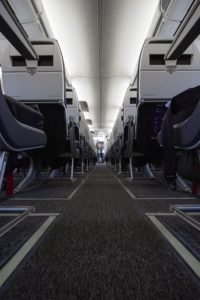Why is this important?
Air travel, particularly long-distance flights, accounts for a large portion of an organisation’s carbon emissions. Employees, notably those working abroad, are often granted perks like round-trip flights for themselves and their families, typically used for holidays or visits home.
Significantly reducing an organisation’s carbon footprint means reducing air travel. This includes both professional and personal travel. As long as the social mission is not impacted, an organisation can no longer choose to encourage, facilitate, and fund air travel. Conversely, organisations can become a major source of action and inspiration for their staff to reduce flights. The growing desire for consistency and climate action by employees, especially the younger generation, can further motivate an organisation to take the leap.
What is the solution?
The solution is to phase out carbon-intensive benefits offered to employees in their employment contracts, such as airline tickets, and instead offer equivalent benefits with a significantly lower climate impact.
Energy cheques, food or bicycle vouchers, culture passes, housing assistance, train tickets, childcare, restaurants, or local tourism are all alternatives that organisations can consider. Alternatives with very different terms and conditions can also be considered, linked to retirement or more advantageous health benefits, for example. Even more innovatively, an organisation may choose to offer employees who choose to take a train rather than a plane for their vacation an extra day off with pay. (1) Organisations can be very creative and even pioneering in this area.
A variety of alternatives exist. It is possible to offer one or more alternatives to replace the airfare. Alternatives can be the same for all employees or flexible. Options can vary from one organisation to another, depending on preferences and situations.
Why is this a key issue for the aid sector?
Air travel, especially long-haul flights, is typically the largest contributor to an organisation’s carbon footprint in the international aid sector. This sector, which provides assistance around the world, relies on a large number of overseas-based employees who traditionally receive benefits such as round-trip airfare for themselves and their families, usually used during vacations to return to their home countries.
Reducing significantly the carbon footprint of an aid organisation means reducing air travel. This includes both business and personal travel. An organisation can choose no longer to encourage, facilitate, and fund air travel of any kind. Conversely, organisations can become a major source of action and inspiration for their staff. The growing desire for consistency and climate action by employees, especially young ones, can further motivate an organisation to take the plunge.
Is it easy to implement?
One might think that it would be easy to implement this change. However, as with any element of a Human Resources policy, it requires a great deal of discussion and negotiation with the staff and their representatives and relies on broad acceptance of the change.
Employee benefits included in employment contracts can have significant emotional value. This can be the case for airline tickets, which can create an almost invisible motivation to work within an organisation. Conversely, applying a more virtuous approach from an environmental and social point of view can lead to a stronger commitment of the staff to an organisation and an increased adherence to its values. It can also help attract new employees, especially young ones.
Key implementation points
Overall consistency
The elimination of high-carbon benefits in favour of low-carbon alternatives must be part of an overall approach by the organisation to reduce its carbon footprint. This approach should be based on a variety of coherent and complementary measures. The climate should not be used as a pretext for an organisation that only wishes to restrict the working and living conditions of its employees without making any efforts to improve its own professional practices.
Acceptance of change, transparency & communication
These evolutions should be explained, understood, and accepted by the personnel of an organisation. Any change tends to arouse fears, reticence, and blockages. To avoid these, it is imperative to communicate to the staff the overall climate objective of the organisation, measures considered, processes that will be put in place to define these changes, including the benefits included in employment contracts, and to remove any concerns from the start. It is important to be understanding and patient, especially with long-term employees who were used to previous arrangements. It is best not to force this through. Perhaps one of the biggest staff concerns will be that alternatives offered will be significantly less attractive financially than airfare. Staff and their representatives should not feel they are losing out.
Inclusiveness
Any such contractual change requires support from social partners. It is critical to inform, consult, and include employee representatives in decision-making processes from the outset and at all stages, including in the identification of alternatives. The organisation can also rely on employee representatives to disseminate information and create broader acceptance of the measure.
Financial and moral equivalence
The estimated value of the proposed alternatives should be equivalent to the airfare benefit, which is generally considered very attractive. Employees need to feel comfortable with this. This is an issue both for retaining current employees and for attracting new ones. This is about financial but also moral value. A personal airplane ticket is often associated with vacations or family reunions, in other words, with leisure and fun. The alternative(s) chosen by the organisation must be attractive, interesting and create an equivalent positive feeling. In addition, as with airline tickets, family situations can be considered when offering alternatives.
How to implement alternatives
It is possible that the implementation of alternatives, especially if they are multiple and varied, may be more complex or time-consuming than booking and reimbursing airline tickets. It is important to be both creative and innovative in the choice of alternatives, but also pragmatic for the sake of administrative simplicity. These difficulties can be easily anticipated and avoided.
Fairness
It is crucial that the change be the same for all, to make it fair and to ensure that it is widely accepted by staff. Airline tickets must eventually be withdrawn from all employment contracts. The measure should not discriminate based on age, seniority, geographical location (headquarters/field), status (permanent, consultant) or hierarchical level (management, supervisors, operators). As far as alternatives are concerned, even though they may differ slightly depending on the context (headquarters/field, value based on cost of living), they should be as non-discriminatory as possible.
Respect for the law
Labour law must be respected in the process of changing these contractual benefits. It may be easier to apply this measure to new employment contracts than to existing ones. Once the decision to change has been approved by the competent bodies, in accordance with the law and the organisation’s collective agreements, it will be applied as is in new employment contracts (renewals or new entrants) without the possibility of negotiation. In existing contracts, the wording of the relevant clauses may sometimes allow for a modification of the benefits without prior agreement of the contracting employee. If this is not the case, a change of benefits should be explained and proposed to the contracting employee, effective only if agreed with him/her.
Key actions
-
#1 Define clear and consistent objectives
Include this measure in a broader climate action plan for the organisation, based on a variety of solutions and with clear and consistent objectives and guidance from management.
-
#2 Communicate
Clearly communicate the objectives (e.g. climate goals, air travel), the process for evaluating benefits (e.g. focus group) and the approach taken (e.g. inclusion of social partners). Communicate the outcomes to all staff (through newsletter, email, or internal messages). Emphasise the commitment to transparency and inclusiveness.
-
#3 Include social partners in the decision-making process
Inform, consult and involve employee representatives, social partners and trade unions from the outset and at all stages of the decision-making process.
-
#4 Estimate the value of the flight ticket benefit
Estimate the financial and moral values of the flight ticket benefit. Employees and staff representatives should not feel like they are losing out.
-
#5 Identify and analyse alternatives
Identify the alternative(s). Ensure that they have a significantly lower carbon footprint than the airline ticket benefit that they are replacing. Be creative and innovative, but also fair and pragmatic.
-
#6 Make decisions
One or several alternatives to air travel; the same offer for everyone or options tailored t0 each employee; a universal approach or one that varies by country; linked to leisure or essential needs?
-
#7 Inform beneficiaries
Communicate the new benefits and the terms and conditions to beneficiaries, distinguishing between new and existing contracts.
-
#8 Loyalty programs
Donate all benefits received through loyalty programs to climate friendly projects.
To consider
-
Potential co-benefits
- Overall consistency with the organisation’s climate objective and social mission.
- Increased sense of ownership among environmentally and socially conscious employees, and increased motivation.
-
Success factors
- Existence of an overall climate objective or strategy within the organisation and a varied and coherent action plan
- Willingness of the part of the organisation’s management and its Human Resources Department
- Broad acceptance by employees
- Multi-actor process including Human Resources, the environmental/ CSR focal point and employee representatives
- Maintained and trusted relationships with employee representatives
- Transparency, communication and inclusivity
-
Prerequisites and specifics
- Availability of sufficient alternatives, in equivalent volume and financial value
-
Potential risks
- Lack of attractiveness of the organisation in terms of recruitment
- De-motivation of staff following a process perceived as imposed or due to less advantageous or unfair alternatives
Tools and good practices
-
A guide on common and best benefits, 2024
Workable provides a comprehensive overview of employee benefits, highlighting popular benefits and offering guidance on how to design and manage effective benefit programs.
Explore here -
Climate Perks Policy - Sustainable Employee Travel
Policy template for companies joining the Climate Perks initiative.
Explore here -
Climate Perks - Case studies
The Climate Perks initiative works with climate-conscious employers to offer paid "travel days" to employees who take the train, bus, or boat instead of the plane on vacation, allowing them to act on their values.
Explore here -
Optimised – Sustainable Employee Benefits
Optimised have introduced a series of policies aiming to provide eco-friendly employee benefits.
Explore here
To go further
-
Acting on the climate emergency: the role of HR, 2019
This HR Magazine article highlights the vital role HR plays in tackling the climate crisis, by emedding sustainability into recruitment, benefits, and culture, and ensuring employees are engaged in climate goals and actions.
Explore here -
WEF - How organisations can harness mployee power for climate goals, 2022
This WEF article explains how companies can engage employees to meet climate goals, by listening to their input, offering green benefits, and building trust through transparency and shared purpose.
Explore here -
Mossy Earth – 7 eco-friendly employee benefits
Mossy Earth presents 7 eco-friendly employee benefit opportunities that help companies boost sustainability and employee engagement.
Explore here
Professional travel

Transport

Economy class tickets only

Sources
(1) Climate Perks, ‘Case Studies’, Climate Perks [no date], Available here, (accessed 25 July 2025).
(2) Climate Perks, ‘Employers’, Climate Perks, [no date], Available here, (accessed 25 July 2025).
(3) Mossy Earth, ‘7 green employee perks with high environmental impact’, Mossy Earth, [no date], Available here, (accessed 28 July 2025).
(4) Society for Human Resource Management, ‘Better Pay and Benefits Loom Large in Job Satisfaction’, Society for Human Resource Management, 2023, Available here, (accessed 25 July 2025).
(5) Independent, ‘Climate crisis: Two years of vegan living cancelled out by one long-haul flight, study suggests’, Independent, 2020, Available here, (accessed 25 July 2025).
(6) Stay Grounded, ‘10 Reasons Why Flying Like Before Covid Is A Really Bad Idea’, Stay Grounded, 2020, Available here, (accessed 25 July 2025).
Acknowledgements
Last updated 18th of of October 2025.
Share your success stories, suggestions, and comments with us! contact@climateactionaccelerator.org
Cover photo © Alexander Bagno/Unsplash.
